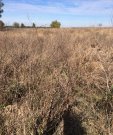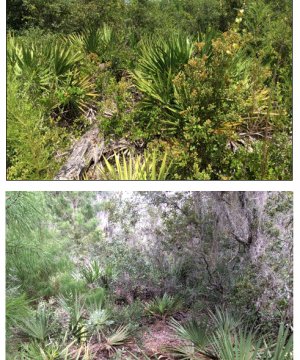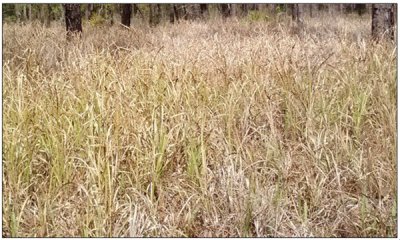
Xeric Bicolor Sandy Uplands
Scenario model
Current ecosystem state
Select a state
Management practices/drivers
Select a transition or restoration pathway
-
Transition T1A
Invasion of noxious non-native plant species (cogongrass)
More details -
Transition T1B
Clear-cut, Mechanical site preparation (ground penetration)
More details -
Restoration pathway R2A
Complete fire suppression (many decades)
More details -
Transition T2A
Invasion of noxious non-native plant species (cogongrass)
More details -
Transition T2B
Clear-cut, Mechanical site preparation (ground penetration)
More details -
Restoration pathway R3A
Mechanical / chemical control of invasive plant species, Mechanical reintroduction of scrub oak species, Frequent fire (1-2 per decade)
More details -
Transition T3A
Mechanical / chemical control of invasive plant species, Mechanical site preparation (ground penetration)
More details -
Restoration pathway R4A
Mechanical reintroduction of scrub oak species, Mechanical site preparation (ground penetration)
More details -
Transition T4A
Invasion of noxious non-native plant species (cogongrass)
More details -
No transition or restoration pathway between the selected states has been described
Target ecosystem state
Select a state
State 1
Xerophytic Scrub SHRUBLAND




Description
State 1 vegetation is scrub or xeric hammock. These natural communities are comprised of dense growths of scrub oaks (myrtle, Chapman’s and sand live oaks) and palmetto (saw and scrub palmetto). Phases within this State vary in their community structure and periodicity of fire (or other natural or anthropogenic disturbances).
Submodel
Description
Planted oak shrubland for the purpose of scrub restoration. This state describes scrubs with restored community structure and function, and restored ecological processes.
Compositionally, restored scrubs are similar to the reference site condition, but lack the full compliment of native scrub plant species.
Submodel
Description
This state describes vegetation dominated by non-native and noxious plant species. Noxious plant dominance changes not only the composition of scrub communities, but structure and ecological dynamics as well.
Submodel
State 4
Active commodity production / fallow





Description
All phases of state 4 (except Phase 4.1) describe commodity land uses of Xeric Bicolor Sandy Uplands. Common crops of Central Florida xeric sands include annual and perennial crops, the most notable of which is citrus (although this is limited LRU 154.2 for the most part). Other crops include horticultural ornamentals, vineyards, and some row crops. Pine plantations managed for community pulpwood production are included in State 4. Additionally, improved pastures of bahiagrass (or other sod forming grass species) are included in this state.
All Phases describe conditions following ground penetrating soil disturbance, and the absence of native plant communities. This includes the extirpation of native populations, including seed banks and dormant propagules, although native weedy species may persist. Depending on the severity and frequency of ground disturbance, soil profile characteristics in the upper part of the soil may be altered.
Submodel
Mechanism
State 1 can transition to State 3 if colonized by highly invasive non-native plant species, particularly cogongrass (Imperata cylindrica). Late successional scrub is much less susceptible to invasion due to diminished availability of light and space. However, cogongrass may colonize open spaces or scrub edges.
Mechanism
State 1 can be converted to commodity land uses (State 4) via clear-cutting followed by land conversion, such as bulldozing, disking, stump removal, chemical application, and planting of commodity crops. Phase 4.1 represents the cleared and initial land conversion condition. From Phase 4.1, many commodity land uses are installed.
Mechanism
In the long term absence of fire, Phase 2.1 can transition to Xeric Hammock, as Sand Live Oak (Q. geminata) overtops other scrub vegetation and forms a closed canopy. The understory and midstory of this restored community may be depauperate of the full suite of native scrub species, depending on natural and artificial colonization prior to succession to xeric hammock.
Relevant conservation practices
| Practice | External resources |
|---|---|
|
Native Plant Community Restoration and Management |
Mechanism
The colonization and aggressive spread of invasive non-native plants can affect the transition to Phase 3.1. Cogongrass is the most aggressive and wide-spread invasive plant species of this Site. Early restoration conditions may be particularly susceptible, given the likelihood of ground disturbance, propagule proximity, and open conditions conducive to cogongrass colonization.
Mechanism
The transition from Phase 2.1 to Phase 4.1 requires clearing of vegetation and site preparation. Specific clearing and site preparation may involve mechanical and chemical applications. Cultivation practices depend on the community goals for the land conversion.
Mechanism
Transition to State 2.1 first requires control and reduction of cogongrass. Fire will not control spread of cogongrass. Repeated tillage throughout a growing season may be sufficient to contain cogongrass spread if the infestation is small (i.e. under 0.25 acres). However, this treatment is insufficient and cost ineffective for larger well-established infestations. In these situations, a combination of burning followed by repeated chemical applications has been found effective. Two active herbicide ingredients found to affect cogongrass growth are glyphosate and imazapyr.
Following cogongrass eradication, site preparation, re-establishment of native oaks, and re-introduction of native fire regimes may affect transition to Phase 2.1.
Relevant conservation practices
| Practice | External resources |
|---|---|
|
Tree/Shrub Establishment |
|
|
Invasive Plant Species Control |
|
|
Herbaceous Weed Control |
Mechanism
Phase 3.1 can be converted to commodity land uses (State 4) with cogongrass eradication followed by land conversion, such as bulldozing, disking, stump removal, chemical application, and planting of commodity crops.
Mechanism
Depending on the severity of site and soil disturbances, State 4 phases may be restored to natural or semi-natural conditions, including the “restored structure and function” scrub (Phase 2.1). This transition may involve clearing, site preparation, and chemical control of undesirable non-native vegetation. Of key importance is the establishment of scrub oaks and palmetto, the dominant scrub plant species.
Relevant conservation practices
| Practice | External resources |
|---|---|
|
Prescribed Burning |
|
|
Native Plant Community Restoration and Management |
Mechanism
Phase 4.1 (cleared/fallow field) may transition to State 3 if noxious non-native plants (i.e. cogongrass) colonize and dominate the site. Cleared fields with soil disturbance are particularly susceptible to cogongrass invasion, if there are nearby propagule sources.
Model keys
Briefcase
Add ecological sites and Major Land Resource Areas to your briefcase by clicking on the briefcase (![]() ) icon wherever it occurs. Drag and drop items to reorder. Cookies are used to store briefcase items between browsing sessions. Because of this, the number of items that can be added to your briefcase is limited, and briefcase items added on one device and browser cannot be accessed from another device or browser. Users who do not wish to place cookies on their devices should not use the briefcase tool. Briefcase cookies serve no other purpose than described here and are deleted whenever browsing history is cleared.
) icon wherever it occurs. Drag and drop items to reorder. Cookies are used to store briefcase items between browsing sessions. Because of this, the number of items that can be added to your briefcase is limited, and briefcase items added on one device and browser cannot be accessed from another device or browser. Users who do not wish to place cookies on their devices should not use the briefcase tool. Briefcase cookies serve no other purpose than described here and are deleted whenever browsing history is cleared.
Ecological sites
Major Land Resource Areas
The Ecosystem Dynamics Interpretive Tool is an information system framework developed by the USDA-ARS Jornada Experimental Range, USDA Natural Resources Conservation Service, and New Mexico State University.



